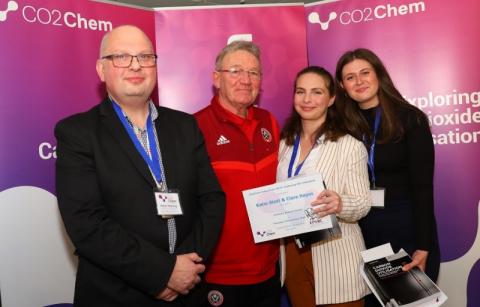We’re Clare and Katie, two chemistry BSc students from the University of York. Our final third-year project centred around finding new and innovative ways to teach chemistry. As we come to the end of our project, we’d like to share with you our experiences and reflect on the opportunities that emerged along the way.
We selected this area of study towards the end of our second year of undergraduate studies. The project was not only of great interest to us from a research angle, but also from our desire to create and discover new technologies to strengthen the link between theory and practice. Throughout the project we considered a variety of target audiences.
We were supervised by Dr Glenn Hurst. Much like our project, Glenn’s research is centred around the field of chemistry education, making him the perfect mentor to guide and support us throughout the project. Perhaps the most innovative example is Glenn’s successful use of social media platforms, in particular Snapchat. This alongside the development of several educational mobile apps, such as “Organic Fanatic”, was designed to reinforce chemistry taught in the classroom. These unique and forward-thinking methods inspired us to find further strategies to present a fresh approach to teaching chemistry in our BSc research project.
The first teaching method we developed was a video. For us, creating a video that was educational yet captured the audience’s attention was a completely new challenge. We were encouraged to enter a competition hosted by CO2Chem by our supervisor Dr Katie Lamb, a current chemistry postdoctoral research associate at the University of York. CO2Chem is a network of carbon dioxide chemistry experts who do amazing work in influencing politicians and policymakers, as well as encouraging collaboration between academic and industrial institutions.
The aim of the competition was to produce a short-form documentary to explain to a non-specialist audience in three minutes or less how carbon dioxide utilisation (CDU) can be used as part of a wider approach to end the dependency on fossil-based resources. Much to our delight, we ended up winning the competition.
Video: Five essential studying tips for students
As part of our prize, we had the privilege of being invited to the CO2Chem Network Annual Status Conference where our video premiered. At the conference we were able to participate in the scientific community for the first time and gained insights into the latest developments in the field of CDU. Our award was presented to us by the Sheffield United and England football legend, Tony Currie, an honour that sparked a little jealousy from our dads.
Upon gaining feedback on our video, we found that the use of subtitles was one of its greatest strengths – 91 per cent of those who watched our video agreed that they were a helpful addition and improved engagement. We chose to add subtitles to make the video accessible to as wide an audience as possible.
Our second teaching method provided an opportunity to work on an international collaborative project with students from the University of Zaragoza in Spain. Together, we developed posters about the valorisation of citric and marine plastic waste feedstocks, which we then shared on Twitter. The project not only allowed us to learn more about the valorisation of waste feedstocks, but helped to develop our communication skills, especially working via Skype with a language barrier, and time management as we had to juggle our partners and our own schedules, plus the time difference.
We are currently in the development stages of creating a TikTok account, “The Chemistry Collective”. TikTok is an increasingly popular social media platform in which users can create short videos set to music, special effects and text. A great feature of TikTok is how easy it is to share the content on other platforms such as Facebook, Twitter and Instagram, which will help us reach a global audience. Using our TikTok account, we hope to encourage young, pre-university individuals to explore chemistry.
Following the success of our video for the CO2Chem competition, we will continue to employ a “systems thinking” approach to contextualise theoretical chemistry taught in the TikTok videos. For example, in one of our features, “Kitchen Chemistry”, we will demonstrate simple chemistry experiments that can be replicated in the kitchen at home. With this idea, we hope to make our content more accessible and stimulating, and to replicate the success of science channels on YouTube, many of which receive millions of views per week.
We will also share content with information regarding sustainability and green chemistry. With many invaluable resources at our disposal, including the Green Chemistry Centre of Excellence at the University of York, the world-leading academic facility for pioneering green and sustainable chemical research, our content will be at the front line of research.
To conclude, our BSc project has granted us the opportunity to create unique learning resources, develop systems thinking and creativity skills, and encourage individuals to take further interest in science. Adapting our teaching methods to suit a wide range of audiences was essential to the efficacy of each teaching resource. This experience has shown us the importance of constantly evolving educational resources in line with ever evolving developments in educational research.
Read more: What can you do with a chemistry degree?

Comments